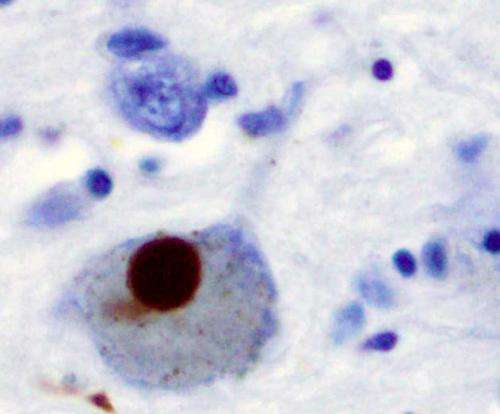Immunohistochemistry for alpha-synuclein showing positive staining (brown) of an intraneural Lewy-body in the Substantia nigra in Parkinson's disease. Credit: Wikipedia
Scientists at the University of Dundee have confirmed that a key cellular pathway that protects the brain from damage is disrupted in Parkinson's patients, raising the possibility of new treatments for the disease.
Parkinson's is a disabling disorder of the brain for which there is no cure. Mutations in two genes called PINK1 and Parkin are associated with early-onset forms of Parkinson's. Both encode distinct classes of enzymes that play a pivotal role in protecting the brain against stress.
Previous research had revealed that when the 'batteries' of cells are damaged, PINK1 can sense this and act as a switch to target and activate Parkin to prevent further damage to the cell. However, it was unknown whether this pathway was active in the brain and was perturbed in Parkinson's patients.
A team of Dundee researchers, in collaboration with scientists across Europe, have identified patients who carry rare mutations in the Parkin gene that precisely disrupt the ability of PINK1 to switch the Parkin enzyme on.
The research confirms the central importance of the PINK1-Parkin switch mechanism in Parkinson's patients and will stimulate future research including the development of drugs designed to switch on the PINK1 enzyme.
The team was led by Professor Miratul Muqit, a Wellcome Trust Senior Clinical Fellow and Consultant Neurologist at the University's MRC Protein Phosphorylation and Ubiquitylation Unit (MRC-PPU).
"We discovered several years ago that the PINK1 and Parkin enzymes operate as switches to protect cells against stress," he said. "In this new advance, we genetically engineered mice to confirm the role of these switches in the brain, however, we did not know whether this pathway really was key in the development of Parkinson's.
"The probability of finding rare patients with the critical mutation to test in the lab was as low as 1 in 3 billion so we are grateful to our collaborators who helped identify these rare patients who have helped us finally answer this question.
"There is currently great interest to directly target PINK1 and Parkin as a potential therapy against Parkinson's and this study strongly backs the rationale of this approach."
Together with researchers at the University of Helsinki, the team tracked down a Finnish patient who had developed early-onset Parkinson's and were able to obtain cells from the patient that revealed that the activity of the Parkin enzyme was defective thereby confirming this as a cause for their Parkinson's.
A second patient in the United States was identified from the Progressive Parkinson's Markers Initiative study, coordinated by the Michael J Fox Foundation.
The research is published today in the journal Open Biology.
Professor Dario Alessi, Director of the MRC-PPU, "This is a wonderful and high-quality study that provides crystal clear fundamental information on how mutations in PINK1 and Parkin genes cause Parkinson's disease. This is the result of six years of painstaking research by Professor Muqit and his lab and lays the groundwork for the development of new treatments for Parkinson's disease."
More information: Thomas G. McWilliams et al. Phosphorylation of Parkin at serine 65 is essential for its activation in vivo, Open Biology (2018). DOI: 10.1098/rsob.180108
Journal information: Open Biology
Provided by University of Dundee





















